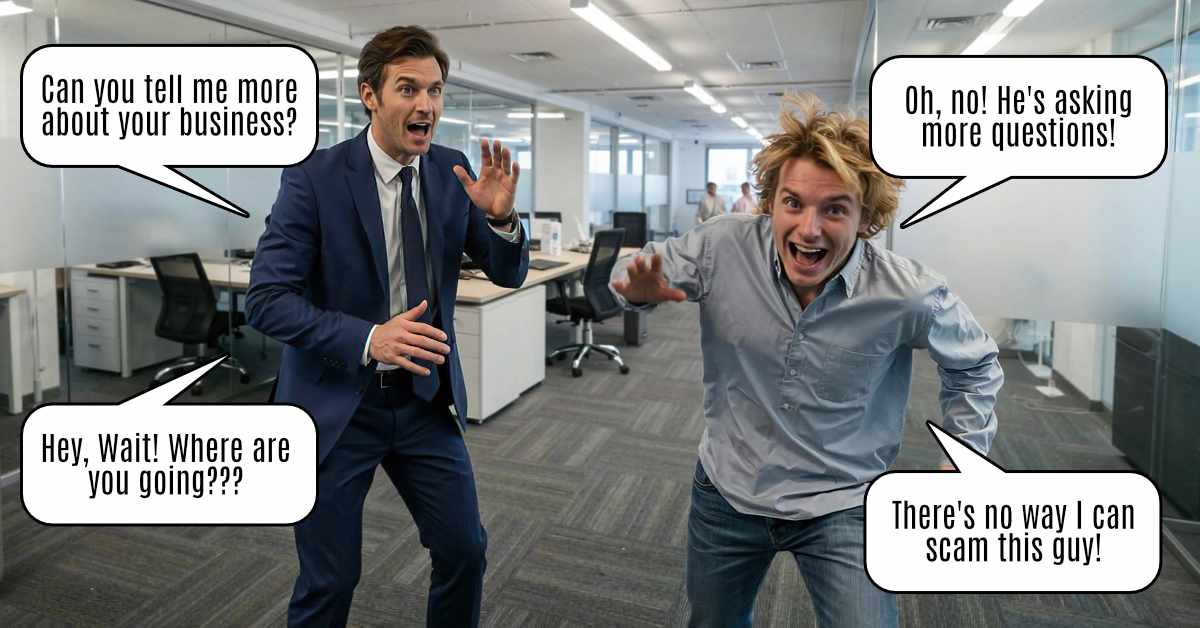Scam Alert: The “Door Supply” Logo Inquiry — Why Asking Questions Protects You

Every so often, artists and designers get messages that sound promising — someone who “found your portfolio,” praises your work, and offers a generous budget. But sometimes, what looks like a business opportunity is actually a scam in disguise.
I had a logo design inquiry recently. The first message from “Branham,” as he called himself, was quite vague. No company information at all — just a niche (“door supply”), a big budget, and a general direction for the logo. I knew it was a scam immediately when he said he was “impressed” by my portfolio on my website. My Instagram feed doesn’t feature any logo design work — my focus these days is on art and pattern design, not branding. That alone told me he hadn’t looked very closely.
Still, I decided to investigate further to see what he’d say if I asked for more information. His Reply was full of red flags.
The Red Flags
No verifiable business information
“Branham” emailed me from a Gmail account with no company website or LinkedIn profile. “B&E Door Supply” didn’t show up anywhere online — not even as a placeholder domain. As Indeed’s guide on spotting fake job postings points out, lack of a digital footprint is one of the clearest early warning signs.Cheque-only payment
He insisted on paying by cheque “through their financial management team.” This is a major red flag. Overpayment scams often start this way — the scammer sends a fake check, it clears temporarily, and then bounces later, leaving the victim liable for the amount. Freelancers Union has an excellent breakdown of this exact scam pattern.Requests for personal information
I was asked for my full name, address, and phone number to “process the cheque.” These are exactly the details scammers use for identity theft or further targeting.Excuse for no video or phone call
“Branham” claimed to have a “hearing issue” and could only communicate in writing. This line has been used word-for-word in numerous freelance scams to avoid live verification. It’s common in many scam types for the same reason.Overly polished business description
The long “About Us” section he sent was clearly AI-generated or copied. It was packed with generic phrases like “trusted provider,” “cost-effective solutions,” and “long-term value.”
How I Responded
Here’s what I wrote back:
“For security reasons, I only accept electronic payment through verified business invoicing platforms such as PayPal Business or bank transfer. I cannot accept cheque payments.
I would also suggest we have a written contract for both of our protection. It ensures everything is agreed to in writing and establishes trust by keeping our agreement transparent and clear while managing expectations for us both.”
I kept it polite and professional — even wished him well with his hearing issue — but I stood firm on verified payment and a written contract.
And just as I expected, he didn’t reply.
Why Scammers Disappear When You Ask Questions
Scammers rely on vagueness and speed. They want you to act before you think. When you start asking detailed, professional questions — or require things like verified payment and contracts — they realize you’re not an easy target and quickly move on.
It’s not confrontation; it’s confidence.
A legitimate client will respect your boundaries. A scammer will vanish.
If you need a refresher on identifying red flags, ClearVoice offers a concise checklist that every freelancer should read.
Lessons for Creatives
Never accept cheques from new clients. Use traceable, secure methods only (PayPal Business, Stripe, direct bank transfer).
This Upwork Safety Guide outlines safe communication and payment practices for freelancers.
Ask for verification early — company name, website, and business email should all match.
Propose a written contract. Real clients won’t object.
Stay polite, but firm. Professional boundaries protect both parties.
Final Thoughts
Asking questions upfront isn’t rude — it’s smart business. It saves you time, protects your identity, and helps you build trust with legitimate clients.
Remember:
Real clients don’t vanish when you ask real questions.
Stay alert, stay professional, and keep creating safely.
Further Reading & Resources
What to Do If You’ve Already Been Scammed
If you think you may have fallen for a similar scheme or provided personal information to a suspicious contact, act quickly. Here are official resources to help you report and recover safely:
Canada
Canadian Anti-Fraud Centre (CAFC): File a detailed report of the scam and any losses.
Canadian Centre for Cyber Security: For online or email-based scams.
Your Local Police Non-Emergency Line: If you’ve lost money or suspect fraud.
United States
Federal Trade Commission (FTC): File a complaint about fake clients, identity theft, or online fraud.
Internet Crime Complaint Center (IC3): Handles internet-related scams, including fake cheque and payment fraud.
Other Regions
You can also forward suspicious emails to your provider’s abuse address (e.g., abuse@gmail.com for Gmail).






2 Comments
Máy tính lương · November 6, 2025 at 9:31 pm
Teresa, excellent breakdown! Its funny how scammers think hearing issue is such a foolproof excuse – maybe they should try my AI told me you were legit? But seriously, your points are spot on. Requiring verified payment and contracts isnt being difficult, its just common sense in this jungle! Gotta love how the real clients just respect your boundaries and move on smoothly, while the scammers vanish faster than a fake cheque in a bank. Keep up the great work, and remember, if they dont reply after you stand firm, just smile and think, Another AI-generated profile bites the dust! 😉
Teresa Cowley · November 7, 2025 at 5:13 pm
Thank you, Máy! As terrible as scammers are, it’s fascinating in a way to see what approach each one uses. They might use the same tactics over and over but their stories and excuses might be different. Asking questions and using professional business practices is the best way to make sure you’re dealing with someone who’s legit. A real client isn’t going to run away and will more than likely appreciate the questions because it shows you care about their project. I feel it’s very important to expose scams, which is why I cover them on my blog and will continue to do so.